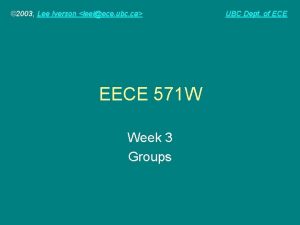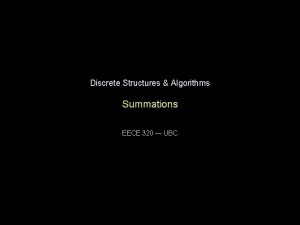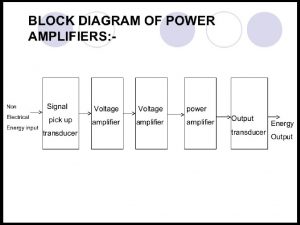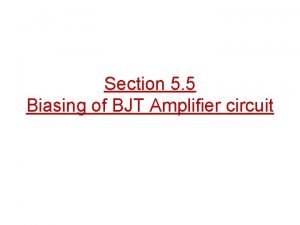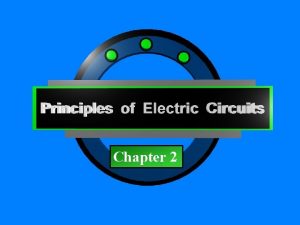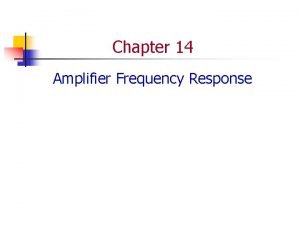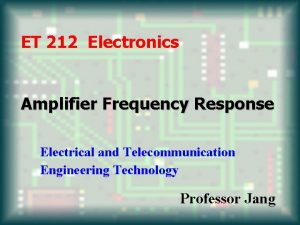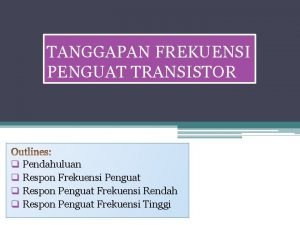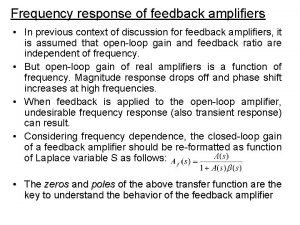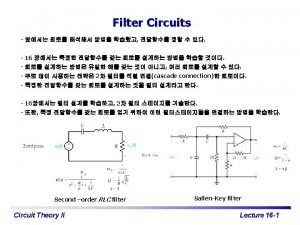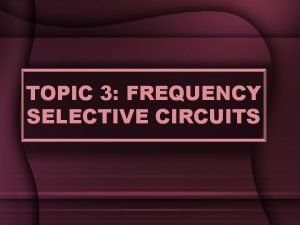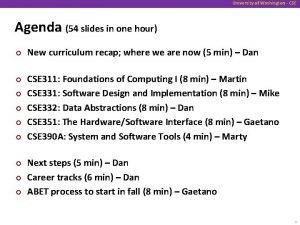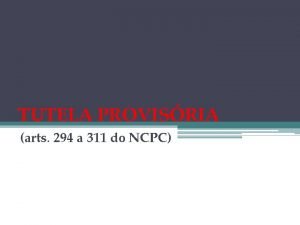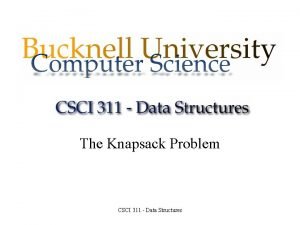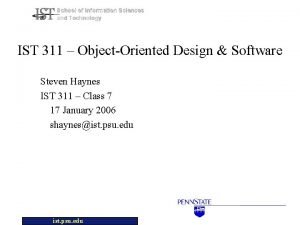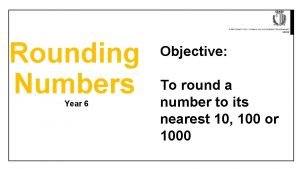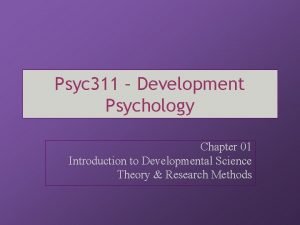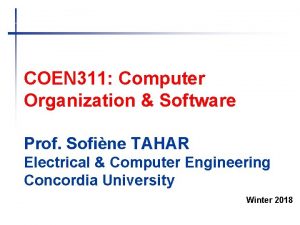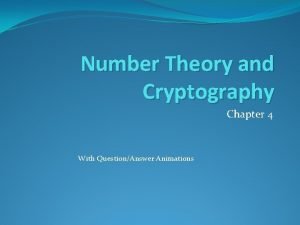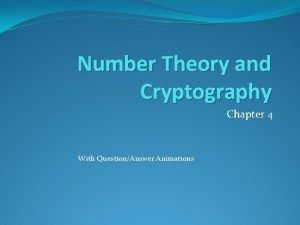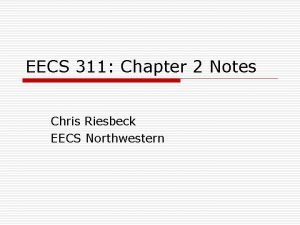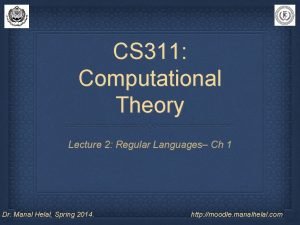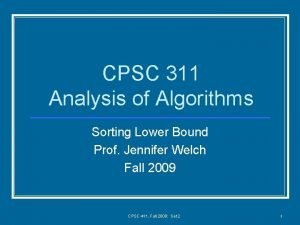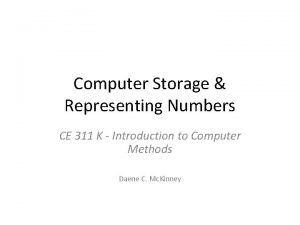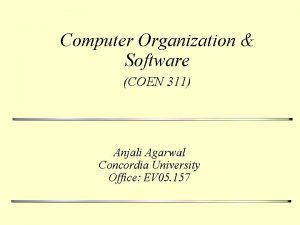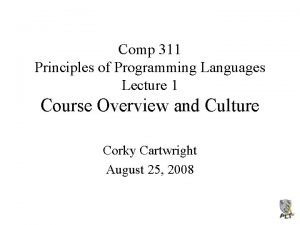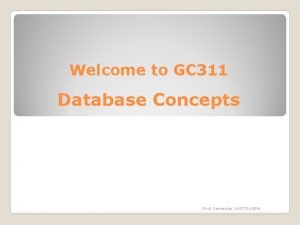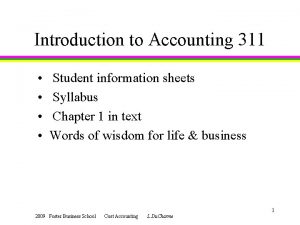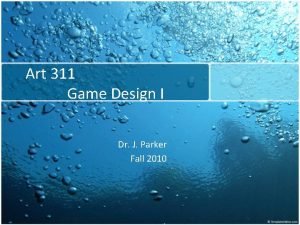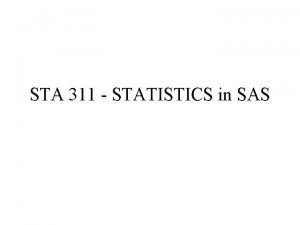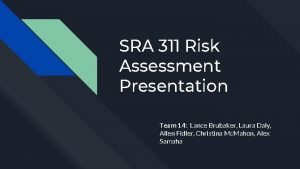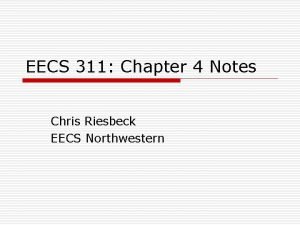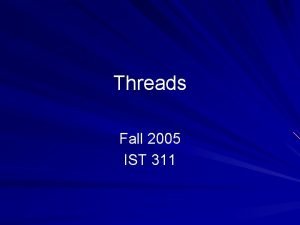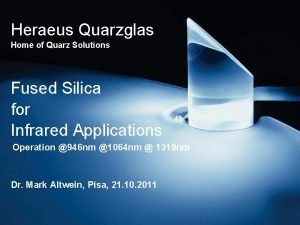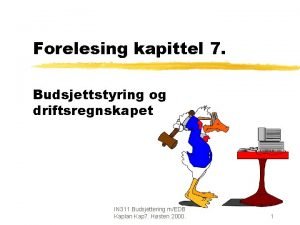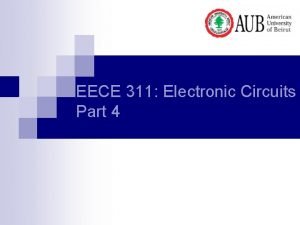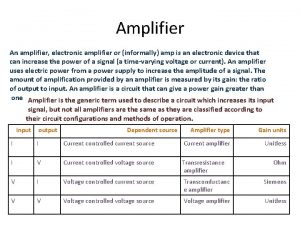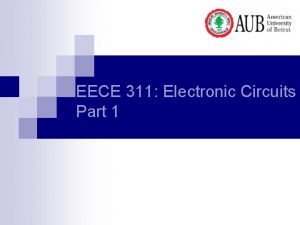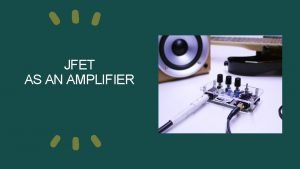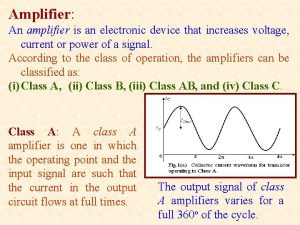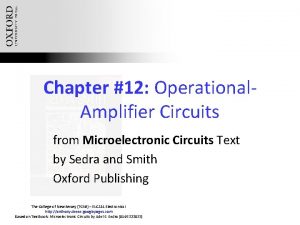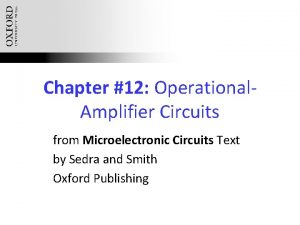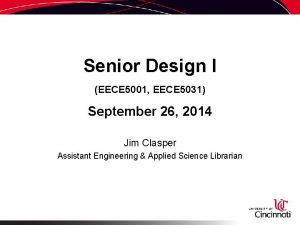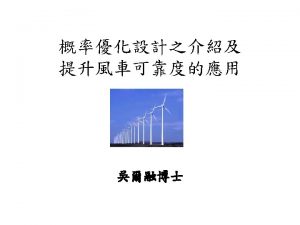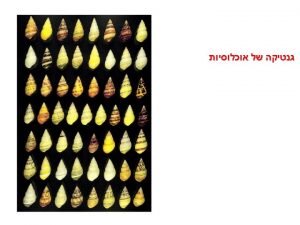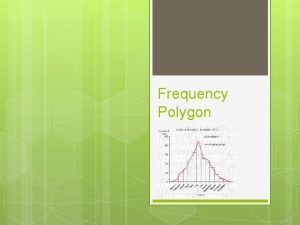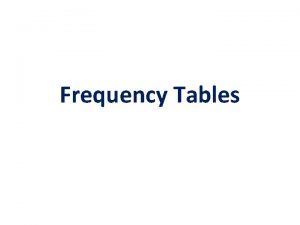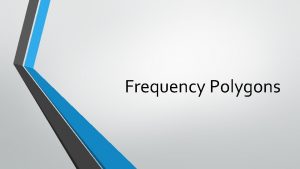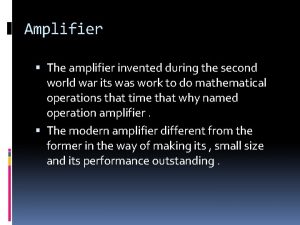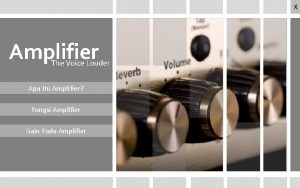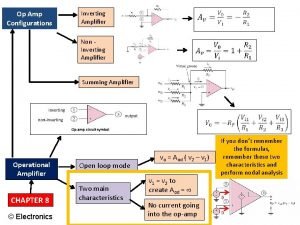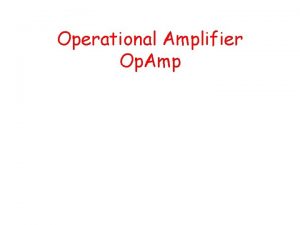EECE 311 Electronic Circuits Part 2 AMPLIFIER FREQUENCY




















































- Slides: 52

EECE 311: Electronic Circuits Part 2

AMPLIFIER FREQUENCY RESPONSE 2

MOSFET High-Frequency Model n The Basic N-channel MOSFET Structure ¨ High-Frequency Small-Signal Model EECE 311 – High-Frequency Models 3

n n When B is shorted to S or body effect is negligible (the usual case) At low frequency, caps are open circuits EECE 311 – High-Frequency Models 4

BJT High-Frequency Model ¨ High-Frequency Small-Signal Model ¨ B’ is the internal base ¨ rx is base spreading resistance B-B’ (small, negligible at low frequency) ¨ Vp = Vb’e EECE 311 – High-Frequency Models 5

DEFINITION: Unity-Gain Frequency Used to find capacitance values n n MOSFET BJT EECE 311 – High-Frequency Models 6

Frequency Response n At low frequency ¨ capacitors are open-circuits (and inductors are short circuits) n n Capacitor impedance ¨ n amplifier characteristics are not affected by frequency (no frequency-dependent elements) Changes with frequency: , Z(jw) = -j /w. C (infinite at DC) As w increases, we need to study the “Frequency Response” Input is ¨ Output is since the system is linear ¨ How do A (magnitude) and f (phase) vary with frequency w? ¨ EECE 311 – Frequency Response 7

Example – How does one capacitor affect amplifier gain? n Given: Blue block is the amplifier n n n Rs = 20 KW Ri = 100 KW Ci = 60 p. F m = 144 V/V Ro = 200 W RL = 1 KW n Find: n n n Vo/Vs Plot n magnitude response n phase response vo(t) when vs(t) = 0. 1 sin 10 nt V for n = 2, 5, 6, 8 EECE 311 – Frequency Response 8

Solution n n Express Vi as a function of Vs Express Vo as a function of Vi EECE 311 – Frequency Response 9

Solution K 1/w 0 n This is of the form: n Low-pass single-time-constant (LP-STC) n K is the low-frequency gain n w 0 is the 3 -d. B frequency EECE 311 – Frequency Response 10

Review: Low-Pass Single Time Constant n Gain (or Transfer) function: n n Low-frequency gain = K Upper 3 -d. B frequency = w 0 n -20 d. B/decade drop at high frequency (w >> w 0) n What is T at w 0? 11

Solution (continued) n Bode Plot - Magnitude EECE 311 – Frequency Response 12

Solution n Bode Plot - Phase EECE 311 – Frequency Response 13

Solution n Output voltage vo(t) when vs(t) = 0. 1 sin 102 t V ¨ vs(t) = 0. 1 sin 105 t V ¨ vs(t) = 0. 1 sin 106 t V ¨ vs(t) = 0. 1 sin 108 t V ¨ For w = 102 rad/sec: ¨ For w = 105 rad/sec: ¨ For w = 106 rad/sec: ¨ For w = 108 rad/sec: ¨ vo(t) = 10 sin(102 t) V vo(t) = 9. 95 sin(105 t – 5. 7 o) V vo(t) = 7. 07 sin(106 t – 45 o) V vo(t) = 0. 1 sin(108 t – 89. 4 o) V EECE 311 – Frequency Response 14

Amplifier High-Frequency Response n n Bode Plot We will not consider low-frequency effects In IC amplifiers, neither bypass nor coupling capacitors are used because of their large size: Amplifiers are directly coupled. 15

n The High-Frequency Gain Function 16

n The Dominant Pole Approximation wp 1 is 2 octaves down (less by a factor of 4) n Better Approximation If one pole is obviously smaller than the other zeroes and poles. 17

n The Exact Solution: Solve |A|=|AM|/√ 2 ωH = √x 18

n Example: Find ¨ Given: ¨ Solution: ¨ Dominant Pole? ¨ Better Approximation: ¨ Exact Solution: 19

n Example: Magnitude Bode Plot ¨ Given: 20

Bode Plot Construction P P Z 21

Bode Plot Construction What is the slope? 22

Bode Plot Construction What is this value (d. B)? What is the slope? 23

Bode Plot Construction What is this value (d. B)? What is the slope? 24

High-Frequency Response of Common Source and Common Emitter Amplifiers 25

At signal frequencies 26

High-Frequency Response of Common Source and Common Emitter Amplifiers n High-Frequency Small-Signal Equivalent Circuits CS: CE: 27

¨ RL represents the output resistance of the active load any load resistance ¨ CL represents the total capacitance between drain (or collector) and ground. It also includes the input capacitance of a succeeding amplifier stage, and parasitic/load capacitances. ¨ We will analyze the CS circuit only since the analysis of the CE amplifier is exactly the same after relabeling Thevenin equivalent for circuit composed of Vsig, Rsig, rx, and rp 28

n Common Source / Common-Emitter High-Frequency Small-Signal Equivalent Circuits 29

n Exact Analysis in s-domain: YC = s. C 30

• Low frequency gain is –gm. R’L • Zero frequency gm/Cgd is very high • What is the 3 -d. B frequency? 31

Miller’s Theorem n When Z is a capacitor C n C 1 = C (1 – K) n C 2 = C (1 – 1/K) 32

n Example 2: Find ¨ Given: ¨ Solution using Miller 33

n Find using Miller’s Theorem 34

n Miller’s Approximation in CS/CE +CL The input circuit and the output circuit are low-pass RC circuits What is the pole frequency for a simple RC circuit? 35

n Miller’s Approximation in CS/CE +CL Output circuit pole at 1/(R’L Cout) Input circuit pole at 1/(R’sig Cin) Usually input circuit determines high frequency response 36

n Miller’s Approximation in CS/CE +CL Input circuit pole at win = 1/(R’sig Cin) Output circuit pole at wout = 1/(R’L Cout) If input pole is not much smaller than output pole 37

n Open-Circuit Time Constants Instead of finding A(s) to get w. H, we’d like to determine w. H directly from the circuit 38

n Find using OCTC 39

40

n Frequently-used resistance calculation 41

n Find using OCTC (cont’d) 42

Open-Circuit Time Constants (cont’d) n Numberical Example: Find ¨ Given: ¨ Solution: OCTC allows us to determine the circuit component(s) that limit the value of w. H 43

n Open-Circuit Time Constants (cont’d) 44

¨ Example 1: CMOS Common-Source Amp ¨ Find f. H using: Miller’s approximation ¨ Open-circuit time constants (OCTC) ¨ Transfer function ¨ 45

¨ Example 1: CMOS Common-Source Amp 46

¨ Example 1: CMOS Common-Source Amp 47

¨ Example 1: CMOS Common-Source Amp 48

¨ Example 2: CMOS Common-Source Cascade ¨ What is the overall low-frequency gain if the per-stage gain is – 42? ¨ What is the 3 -d. B frequency if the per-stage 3 -d. B f. H is 6 MHz?

Solution 50

Example 3: Common-Emitter Amplifier n Find the 3 -d. B frequency f. H using Miller’s approximation n Assume that the input circuit determines the value of f. H 51

Solution 52
 Eece 571f
Eece 571f Summations
Summations Difference between voltage and current
Difference between voltage and current Bjt amplifier circuit
Bjt amplifier circuit Advantages of parallel circuits over series circuit
Advantages of parallel circuits over series circuit Principle of electric circuit
Principle of electric circuit Advantages of multistage amplifier
Advantages of multistage amplifier Formula for cutoff frequency
Formula for cutoff frequency Frequency response curve of an amplifier
Frequency response curve of an amplifier High frequency transistor amplifier
High frequency transistor amplifier Frequency response of feedback amplifier
Frequency response of feedback amplifier Filter circuits
Filter circuits Frequency selective circuits
Frequency selective circuits Frequency selective circuits
Frequency selective circuits Scrip exchange
Scrip exchange Electronic field production examples
Electronic field production examples Joint frequency
Joint frequency How to calculate relative frequency
How to calculate relative frequency Power of sine wave
Power of sine wave Vmax = aw
Vmax = aw Relative frequency bar chart
Relative frequency bar chart What is a marginal frequency
What is a marginal frequency What is a relative frequency table
What is a relative frequency table Uw cse 312
Uw cse 312 Art 294 a 311 novo cpc
Art 294 a 311 novo cpc Csci 311
Csci 311 Ist 311
Ist 311 311 rounded to the nearest ten
311 rounded to the nearest ten Psyc 311
Psyc 311 Rtca do-311
Rtca do-311 Rpv 311
Rpv 311 Coen 311
Coen 311 The number 311-38 is divisible by prime numbers:
The number 311-38 is divisible by prime numbers: Number theory
Number theory Ssis 311
Ssis 311 Psyc 311 textbook notes
Psyc 311 textbook notes Cs 311
Cs 311 A2yes
A2yes 311 k
311 k Coen 311 concordia
Coen 311 concordia Comp 311 study guide
Comp 311 study guide Gc 311
Gc 311 Accounting 311
Accounting 311 311 game
311 game 311
311 Psyc 311 study guide
Psyc 311 study guide Sta311
Sta311 Sra 311
Sra 311 Was ist rdbms
Was ist rdbms Chris riesbeck
Chris riesbeck Ist 311
Ist 311 Suprasil 311
Suprasil 311 In 311
In 311
